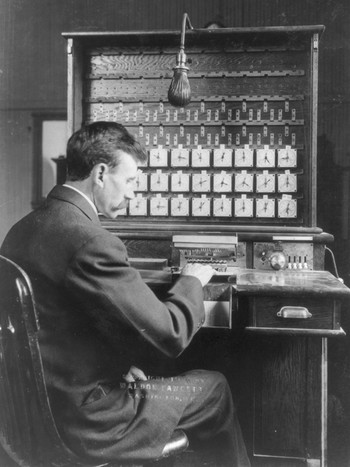Shortly after Herman Hollerith 1879SEAS, 1890GSAS graduated from college at age nineteen, his engineering professor William P. Trowbridge offered him a job: statistician for the 1880 US census. Hollerith accepted, and a technological revolution began.
The Buffalo-born son of German immigrants, Hollerith witnessed firsthand the inefficiencies in a census process intended to count and categorize fifty million people. The 1880 census took seven years and cost around $5.8 million — an exorbitant figure at the time. Given the growing US population, the 1890 census promised to be even more difficult and expensive. Hollerith believed he could do better.
His method for compiling statistics, which formed the basis of his PhD dissertation, involved punch cards using a numerical code: “If it is desired to record each single year of age, twenty spaces are used, divided into two sets of ten each, designated, respectively, from 0 to 9. One set of ten spaces is used to record the tens of years of age, while the other set is used to record the units of years of age. Thus, twelve years would be recorded by punching 1 in the first set, and 2 in the second; while 21 years would be recorded by punching 2 in the first set, and 1 in the second set,” Hollerith wrote in 1889. “Occupations may be arranged into arbitrary groups, each such group being designated, for example, by a capital letter, and each specific occupation of that group by a small letter. Thus, Aa would designate one occupation, Ab another, etc.”
An electromechanical apparatus could read data via the holes in the cards, explains Frank da Cruz ’71GS, ’76SEAS, an expert on Columbia’s rich computing history. “A wire would pass through the holes into a cup of mercury beneath the card, thus creating an electrical circuit,” says da Cruz. “This process triggered counters and sorting bins, enabling the data to be tabulated.”
Hollerith’s invention, which marked the birth of mechanical coding and prefigured the binary language of modern computers, impressed the Census Bureau, which used it for the 1890 census. Sixty-three million “Hollerith cards” — 6 inches wide by 3¼ inches high and printed with numbers and letters that could be punched in binary combinations — were fed into forty-three Hollerith tabulating machines. The job took less than three years and saved the US millions of dollars in projected costs.
In 1896, Hollerith founded the Tabulating Machine Company, which was amalgamated into the Computing-Tabulating-Recording Company in 1911. Hollerith stayed on as a consultant until he retired in 1921. Three years later, the outfit was renamed the International Business Machines Corporation, or IBM.
Hollerith died in 1929. Shortly before this, Columbia education professor Benjamin D. Wood, seeking ways to automate test scoring, contacted the CEO of IBM, Thomas J. Watson. In response, Watson donated data-processing machines that were based on Hollerith’s principles. This allowed Wood to set up the Columbia University Statistical Bureau in Hamilton Hall, where the machines were also used by the astronomy department. Watson became a University Trustee in 1933 and funded the Watson Lab at Columbia, which spawned the world’s first computing class in 1947. It also served as the workshop where John Lentz, who taught engineering at the School of General Studies, designed the IBM 610, which he completed in 1956 — arguably the world’s first personal computer.
Meanwhile, Hollerith’s tabulation system had spread to other fields, such as elections, starting in the 1960s. For more than fifty years it was the standard for tallying votes, until it was supplanted by technology that would obviate problems such as those that occurred in Florida during the 2000 recount, when the term “hanging chad” — it might as well have been called a “hanging herman” — entered the lexicon. IBM’s punch-card voting system, the Votomatic, was last used in two counties in Idaho in 2014.
Hollerith, who was married and had six children, lived out his years in Washington, DC, and that’s where his relics are preserved today. His papers are in the Library of Congress, and his tabulating machine resides with the Smithsonian Institution, along with his framed diploma from Columbia.
This article appears in the Fall 2024 print edition of Columbia Magazine with the title "Packing a Punch."



